We believe it is important to continually support the amazing people dedicating their lives to the arts because a healthy and happy society needs a regular dose of art. There are many important voices and so much talent in Vancouver that we want to bring to your attention. As much as we wish we could bring you into their studios or exhibitions, for now we are delighted to bring a selection of art directly into your home through a series of online catalogues. For our first edition, we have selected 12 Vancouver-based artists that have original works available under $500.
The selections range from geometric abstract compositions to contemplative narrative landscapes and figurative works with social commentary, in an effort to present a panoramic view as a testament of Vancouver’s cultural diversity. We have focused primarily on watercolours, acrylics, and oils on paper and canvas and look forward to creating more catalogues which will feature other mediums. You will find a brief interview under each profile where we hope you will enjoy reading about the artist’s inspirations, interpretations and thoughts on why it is important to live with art.
Assembling these works had us thinking even more about the privileges and delights of owning, looking and unraveling an artwork. We want to share with you the benefits of acquiring an original artwork, living with it or gifting it. Purchasing an artwork is a thrilling experience and living with one is an adventure that allows the owner to weave a deeper level of appreciation into their life.
We’d like to thank Monica Reyes Gallery, TAS Vancouver and the participating artists for their special contributions to this catalogue. Inquiries and sales will be sent directly to the artists or to the platforms supporting them. We merely intend to act as a window into the rich arts offer of this city.
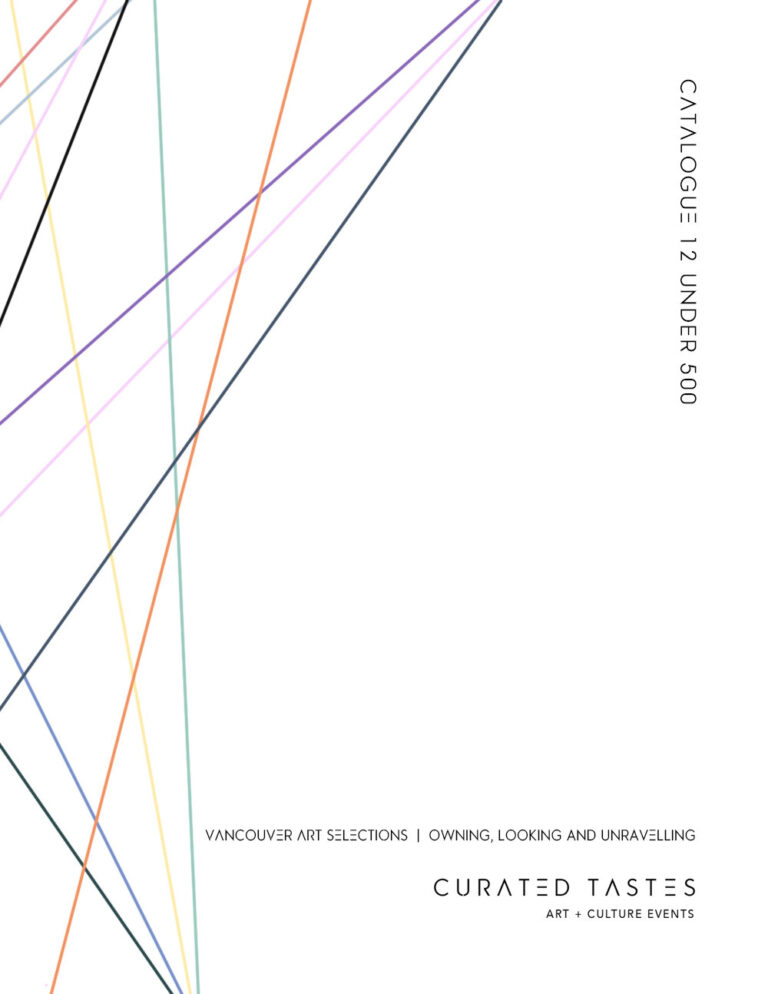
SELECTED ARTISTS
Nadia Baker
Emiko Mizukami
Tiffany Blaise
Deborah Bakos
Olga Rybalko
Erin Harrison
Jack Kenna
Teo Monsalve
Katherine Duclos
Sara Khan
Alison Fast
Tereza Tacic
Click this link for a catalogue view or scroll down for a list view.
 Nadia Baker is a biologist and artist. Based in Vancouver, she graduated from the University of British Columbia with B.Sc. Honours in Environmental Sciences in 2000. Working in painting, photography, mixed media and various printmaking techniques, her pieces explore the juxtaposition of urban and natural environments.
Nadia Baker is a biologist and artist. Based in Vancouver, she graduated from the University of British Columbia with B.Sc. Honours in Environmental Sciences in 2000. Working in painting, photography, mixed media and various printmaking techniques, her pieces explore the juxtaposition of urban and natural environments.
She has frequently participated in the Vancouver Eastside Culture Crawl, and exhibited in Vancouver at the Federation Gallery, Britannia Art Gallery and at Malaspina Printmakers. Additional group exhibitions include the Orange County Center for Contemporary Arts in Santa Ana, and the Los Angeles Printmaking Society 20th National Exhibition. She has been a member of the Eastside Culture Crawl since 2008.
How did your visit to Joshua Tree National Park inform your Boulder Fantasy series? ‘My current work is inspired by a recent visit to Joshua Tree National Park. I was drawn to the enormous desert boulders and the arch-like form they share with rainbows. In the Boulder Fantasy series, I combine the boulder shape with a child-like vision to create an imaginary landscape. In this series colourful lush vegetation of blooming flowers, waterfalls, and crystals come together with the boulders, to reimagine an unreal and welcoming environment.’
Can you tell us more about the materials and support you chose to use for this series? How did these soft textures help you evoke these imagined landscapes? ‘I have used acrylic gouache to create the boulders; crystals, flowers and grass details are added with brightly coloured pastels on Mi-teintes paper. I love using the Mi-teintes touch paper which has a slight grain to it that captures the chalk pastel on the paper. The paper comes in a great selection of colours which I can’t resist using for the background. The sennelier pastels are creamy like butter and help bring texture and life to my landscapes. While the chalk pastels are very delicate and crumble leaving dusty wispy strokes. Why is it important to live with art? ‘Living with art gives me the experience of another way of being, another way of seeing. It adds a dimension to my life I can’t get any other way. When I make art, time slows down and I get lost in the moment. It feels so good.’
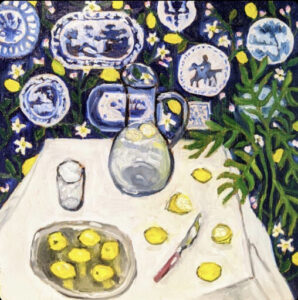 Emiko Venlet was born and raised in Fukui, Japan surrounded by the sea and mountains. She is currently living in North Vancouver, Canada and is once again connected to mountains and the seaside. Emiko’s current work is to remind us of the dreamy and magical places in our hearts and the new chapters those places bring in our lives. She paints and draws imaginary interior scenes with still life’s in them.
Emiko Venlet was born and raised in Fukui, Japan surrounded by the sea and mountains. She is currently living in North Vancouver, Canada and is once again connected to mountains and the seaside. Emiko’s current work is to remind us of the dreamy and magical places in our hearts and the new chapters those places bring in our lives. She paints and draws imaginary interior scenes with still life’s in them.
In her youth Emiko’s connection to her mother and grandmother instilled an appreciation for working with her hands, learning Japanese crafts as well as preserving food and cooking. This natural instinct has led her to drawing and painting. Her early work focused on recreating her visions of inner landscape in abstract form. These images have shifted towards more narrative still life work in oil and acrylic including vintage furniture, flowers, fruit, wallpaper and all things that have nostalgic feel to them; the common thread being an inner exploration of memories and stories.
Emiko is a poet, a tarot card reader and a storyteller. She is a self-taught artist and practices art at home and at Gore Ave. Studio downtown Vancouver, Canada
Your paintings seem to engage in a conversation with Matisse’s still life and indoor scenes which in turn borrowed elements from traditional Japanese wood cuts. Is this some sort of mise en abyme? ‘I am a storyteller before I am an artist and I am a story collector as well. What that means to me is that I believe we are patchworks of all sorts of stories within ourselves.
‘Matisse’s art has a huge influence on how I see the world and so does Van Gogh. And it was so interesting you mentioned that you saw some elements of Japanese woodcuts in my paintings because I am Japanese, born and raised. growing up seeing all sorts of art and crafts everywhere that have Japanese woodcuts influence in them naturally trained my eyes and flavours as to how I tell stories through colours, forms and marks.
‘Is there some sort of mise en abyme in the intention of my paintings? I didn’t intend to use this technique in my paintings per se, however, I can see why it appears to be so. I think we are made with all sorts of borrowed elements and we tell stories with and through those borrowed elements, creating our own stories. I like creating a story within stories patchworked together to show we are all sorts of things. Maybe that intention comes through my paintings.’
Lemons, lemons, lemons. What is it about them? ‘Lemons! Oh lemons and lemons! Don’t you love them? I created this lemon series because I literally was going through my life in a state of “when life gives you lemons!”. It’s not like apples that are round, warm coloured and sweet with almost every bite pleasant. Lemons are bitter skinned and incredibly sour inside. Also, they are misshaped sometimes and they have different faces, almost, at different angles. I wanted to capture what life was giving me at that time; bitterness, sourness, not smooth at all, but then lemons can change into some many different amazing things. Painting this series was a set of hope and different perspective in life for me. Refreshing and invigorating. And also, lemons are just so much fun to paint!!’
Why is it important to live with art? ‘It’s important to live with art because it is a reminder that we are all creative beings. Creative being means not just artists or crafters per se. We all have the power to imagine and create our life. Living with art stirs your emotions and imagination. You get inspiration and invitation to getting to know yourself and your life more profoundly. Why wouldn’t anyone want that?’
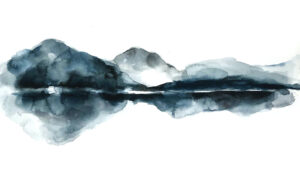 Tiffany Blaise lives and works in Vancouver, Canada. She earned a BFA from Concordia University, where she was the proud recipient of the 2012 Surface 3 Award for emerging design talent. The artist’s work has been displayed in Vancouver, Montreal and Melbourne, including exhibits at The Telus World of Science, The Silk Purse, and the Montreal Art Matters Festival. Her artwork is held in both private and commercial art collections internationally.
Tiffany Blaise lives and works in Vancouver, Canada. She earned a BFA from Concordia University, where she was the proud recipient of the 2012 Surface 3 Award for emerging design talent. The artist’s work has been displayed in Vancouver, Montreal and Melbourne, including exhibits at The Telus World of Science, The Silk Purse, and the Montreal Art Matters Festival. Her artwork is held in both private and commercial art collections internationally.
What does the landscape mean to you? ‘When I think of the word landscape, I think of both the exterior environment around us and our interior “internal landscapes”, and the harmony between the two. Many of my paintings are created with this relationship between the external and internal in mind.’
You work across a range of media. What do watercolours offer that acrylics or oils don’t? ‘Watercolours have this beautiful fluidity and subtle transparency that is so fun to work with. I just love their free-flowing nature and ability to take on a life of their own while you’re painting with them. Recently I have been experimenting with mixed mediums to achieve a combination of unique effects in my newest paintings, and find harmony between soft free flowing paint strokes and textural shapes.’
Why is it important to live with art? ‘I think living with art is so important because it enriches our everyday spaces through its power to provide a means of personal expression and uplift our spirits. It also adds colour to our world and makes our spaces more exciting and beautiful!’
Deborah Bakos is a painter and mixed media artist. She holds a Certificate of Fine Arts/Painting from Emily Carr University and a Bachelor of Education in English/Media Literacy from Simon Fraser University. Her photo based paintings and textile installations address global concerns regarding the portrayal of women in media as well as the impacts of climate change. Deborah’s artworks are exhibited in public spaces and commercial galleries with paintings held in international and local collections/publications in Vancouver, Istanbul, Toronto, Cincinnati USA, San Jose Del Cabo, Mexico and Treviso, Italy.
Deborah is a former Humanities Educator (English Literature and Social/Media Studies) with 14 years of experience, culminating with the published curriculum for the University of Victoria’s Center for Addictions Research. She is also a member of the female art collective 13 Feet Off the Ground and an exhibiting/founding member of the annual Parker Art Salon. Through artwork donation, she is an annual supporter of numerous not-for-profit organizations related to women, children and health and the environment.
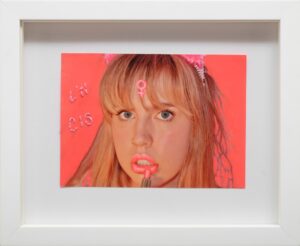 How did your experience in Istanbul help you focus in your art practice? ‘I was at my bravest and most vulnerable when I lived and painted in Istanbul. At first, even simple things like buying eggs or hailing a taxi was a harrowing learning experience because of language barriers and my fledgling understanding of cultural norms. I was acutely aware of my surroundings, the people, the architecture, the history, the light. I learned there is nothing better for me than being a little uncomfortable. Having all my senses and assumptions challenged, it turns out, is a boon when it comes to inspiration for my art practice. From a practical perspective, I was able to shed most of the less glamorous tasks associated with motherhood. My children were picked up by a bus, shuttled out our gated and heavily guarded complex and taken to their International school, where they were served breakfast and lunch. I didn’t touch laundry, a vacuum or rubber gloves for the two plus years I lived in this city. Home support was affordable. I was so grateful for it. Time and space were suddenly mine and I was there for all of it. My art practise found its beginnings in Istanbul. I needed to seek out local artists to work with in order to fulfill my last semester of credits for Emily Carr University Certificate of Fine Arts. Because of this, I found lovely, Cevgi Cagal and Studio 19. I had my first exhibition with her. In the process of reaching out, I also discovered the International Women of Istanbul (IWI). It wasn’t hard to connect with other artists in this group. With them I committed to seeing, learning about, creating and exhibiting art at every opportunity. It was magical.’
How did your experience in Istanbul help you focus in your art practice? ‘I was at my bravest and most vulnerable when I lived and painted in Istanbul. At first, even simple things like buying eggs or hailing a taxi was a harrowing learning experience because of language barriers and my fledgling understanding of cultural norms. I was acutely aware of my surroundings, the people, the architecture, the history, the light. I learned there is nothing better for me than being a little uncomfortable. Having all my senses and assumptions challenged, it turns out, is a boon when it comes to inspiration for my art practice. From a practical perspective, I was able to shed most of the less glamorous tasks associated with motherhood. My children were picked up by a bus, shuttled out our gated and heavily guarded complex and taken to their International school, where they were served breakfast and lunch. I didn’t touch laundry, a vacuum or rubber gloves for the two plus years I lived in this city. Home support was affordable. I was so grateful for it. Time and space were suddenly mine and I was there for all of it. My art practise found its beginnings in Istanbul. I needed to seek out local artists to work with in order to fulfill my last semester of credits for Emily Carr University Certificate of Fine Arts. Because of this, I found lovely, Cevgi Cagal and Studio 19. I had my first exhibition with her. In the process of reaching out, I also discovered the International Women of Istanbul (IWI). It wasn’t hard to connect with other artists in this group. With them I committed to seeing, learning about, creating and exhibiting art at every opportunity. It was magical.’
Can you tell us how photography and embroidery play an important role in your Relative Obscurity series? ‘For me, memories are constructed with personal photography more than by fleeting recollection. Photographs have permanence. They exert control over personal narratives because we can literally see ourselves in them, over and over again. Relative Obscurity began with the idea of challenging my own family’s narrative. I wanted to poke at patriarchal traditions, gendered messaging, religious dogma and my own notions of femininity and self-worth. It seems there was no better way to subvert my story than to alter the settings and contexts with paint and humour. Adding embroidery, ribbon, beads and other girlie embellishments to my painted photographs is the next progression in this body of work. I learned to sew, stitch and bead at an early age, but I put all this aside when I started studying ‘real art’. To reclaim these skills as time honoured, time spent, important women’s work on par with painting and photography, is my goal. I also want my work to seem lived with, carefully handcrafted, carefully planned, unlike the future.’
Why is it important to live with art? ‘Art is our personal truths, laid bare. It’s important to live with art because it mirrors the depths of our humanity.’
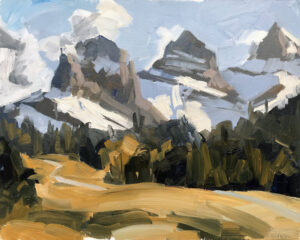 Olga Rybalko is a representational painter who captures the natural landscape with a unique attention to the magic of each place. She combines her artistic passion with her love of travel to create scenery that captures the mind and the heart. ‘My art is all about capturing a place – not the exact look of it, but how it feels to be there. When I paint, I feel like I am there, and that is what I want to translate to the viewer.’
Olga Rybalko is a representational painter who captures the natural landscape with a unique attention to the magic of each place. She combines her artistic passion with her love of travel to create scenery that captures the mind and the heart. ‘My art is all about capturing a place – not the exact look of it, but how it feels to be there. When I paint, I feel like I am there, and that is what I want to translate to the viewer.’
Can you tell us about a memorable moment you had during a camping or hiking trip? What sort of thoughts and feelings does Mother Nature evoke on you? ‘One of the most amazing moments from a hiking trip for me was on the West Coast Trail, Vancouver Island. I remember realizing on the second day of the hike that there is absolutely zero cell reception and it’s going to be like this for the next 6 days. I couldn’t be distracted with emails or notifications, and even if anything happened back home, I couldn’t be reached until I got to the end of the journey. All I had to do in a day was get to the next campsite and enjoy the sights and sounds of the trail along the way. The freedom of it was incredible, and it allowed me to place all of my focus on the natural landscape around me.’
What is the significance of plein air painting in your practice? ‘Plein air painting plays a big role in my art practice. Being primarily a landscape painter, it really helps to immerse myself in a scene and capture it from life. Plein air painting really trains the eye to see colour and tone in a more natural way as opposed to looking at photo reference. It also allows me to spend more time with a landscape scene and notice different things and see how the light changes over time.’
Why is it important to live with art? ‘Since art has always been an integral part of my life, it’s hard for me to imagine a life without it! The walls of my studio are full of my works, and my walls at home are full of artworks I’ve collected from friends and artists I admire. To me, it’s like having windows into multiple worlds that you can go and explore at your leisure. Art can inspire creativity, capture a powerful memory, or be a reminder of an important goal. It’s something that you see every day in your home and it’s a chance to enhance your living experience.’
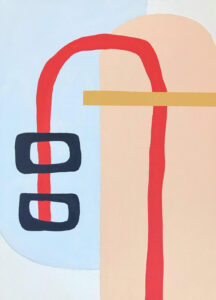 Erin Harrison is an emerging artist based in Vancouver, BC whose practice explores how we personally identify with the relationship between space and form.
Erin Harrison is an emerging artist based in Vancouver, BC whose practice explores how we personally identify with the relationship between space and form.
Creating minimalist abstract paintings, Erin aims to break down the complexity of her surrounding environment into simple and carefully considered compositions.
Delicately and deliberately balancing shapes and colour, Erin creates bold compositions that encourage curiosity. Successfully playing with depth and perspective, the forms in each painting create a narrative for the viewer, allowing us to decipher and allocate meaning to their abstraction.
Erin continues to create work that is relatable universally, with the purpose of inspiring creative thought and emotional exploration. The following works by Erin are presented by TAS Vancouver.
Your work seems to be the result of playing around with color, shape and space relations. Can you tell us a little bit more about your process? ‘Colour and shape are two very important components in my work. I like to consider how they occupy the space and the relationship they have to one another. I use them to create tension, and to play with perspective through layering. Everyone tends to see and feel something different when looking at my work, which I love! My intention with every piece is to create an image that spikes curiosity in the viewer but doesn’t necessarily have a distinct interpretation.’
How does your background in fine arts and interior design reconcile in your work? ‘Every experience we have contributes to the next. Fine arts encouraged me to think way outside the box and really nourished my creativity as well as my technical skills in an amazing way! Interior Design is all about objects and space, and really thinking about how people interact with them. My current art practice is definitely a blend of these two very interesting worlds.’
Why is it important to live with art? ‘No space ever feels complete until the art is on the wall, and there’s a reason for that! Art connects us on a human level, and can bring that connection to our spaces. It inspires conversation, thought and simply makes us happy. It’s always been very important to surround myself with art, it just feels good!’
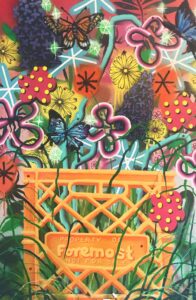 Jack Kenna is a visual artist born and raised in Durango, Colorado (1994) who has lived in the Pacific Northwest for the past seven years between Seattle and Vancouver. Kenna engages with drawing, painting, sculpture, and writing, often blurring the boundaries between media. His works contain a visual vocabulary of objects and motifs that are repeated and reorganized from work to work so as to evolve and complicate meaning over time, utilizing 2- and 3-D media combined with found images, objects, or text. He also works to engage young and emerging artists in his community through education and public programming initiatives. Recent exhibitions include ‘A Clog in the Machine,’ a solo exhibition at The Alternator Gallery in Kelowna, ‘Gridworks,’ a solo exhibition at Slice of Life Gallery in Vancouver, and ‘In Over Our Heads,’ a group exhibition at Franc Gallery, Vancouver. Kenna holds a BFA from Emily Carr University 2019.
Jack Kenna is a visual artist born and raised in Durango, Colorado (1994) who has lived in the Pacific Northwest for the past seven years between Seattle and Vancouver. Kenna engages with drawing, painting, sculpture, and writing, often blurring the boundaries between media. His works contain a visual vocabulary of objects and motifs that are repeated and reorganized from work to work so as to evolve and complicate meaning over time, utilizing 2- and 3-D media combined with found images, objects, or text. He also works to engage young and emerging artists in his community through education and public programming initiatives. Recent exhibitions include ‘A Clog in the Machine,’ a solo exhibition at The Alternator Gallery in Kelowna, ‘Gridworks,’ a solo exhibition at Slice of Life Gallery in Vancouver, and ‘In Over Our Heads,’ a group exhibition at Franc Gallery, Vancouver. Kenna holds a BFA from Emily Carr University 2019.
Does the legacy of pop and neo-pop seep into your work? How did milk crates meet synthetic flowers, plants, long balloons amongst other found objects? ‘I think that it certainly does, although I never really consider art historical genres when I set out to make something. When I started painting milk crates a few years into school, I was at a really frustrating, stagnant point in my development and I decided to just paint what was around me. I’ve been collecting milk crates since I was a teenager, because I like the way they look but also because of their functionality and utilitarian nature. For a while I was just stacking them up in funny arrangements in my studio and painting them, but eventually I started changing it up and adding in other objects to keep it interesting. The crates have become the perfect vessel for depicting other subjects, be it flowers or balloons or whatever. I have a lot of fun with taking something banal and unremarkable, like a crate, and putting it on a pedestal as the subject of a painting. And then as I make more and more works with the crates, over time they sort of recede into the background again, in a way. I’m interested in repeating motifs throughout works so that their meanings deepen and become more complex over time.’
Can you tell us more about your process? What happens between seeing/finding an object and immortalizing it into different media? ‘I do a lot of drawing and writing and always keep a notebook around for writing down ideas, otherwise I also maintain a chaotic page of notes on my phone. But usually I’ll notice something throughout the day that interests me and write it down for later. I often like re-making works over and over, or translating them through media, figuring out the best way to make the work. I draw and paint the most but I also work with ceramics, stained glass, sculpture and creative writing, and I’m always looking for cohesive ways to combine two or more of these practices in a work. I’ve also started collecting a lot more too – aside from milk crates, I also collect weird objects and trinkets that hold significance to me somehow, and they all sit on a shelf in my studio so they get a lot of careful consideration. Eventually they find their way into the paintings.’
Why is it important to live with art? ‘Like I previously mentioned, I’m a bit of a collector, so art is no exception. I collect t-shirts, zines, artworks, and tattoos. For me it’s about supporting my friends and also getting to connect with artists that I admire. Once you have somebody else’s work, you have a little bit of them with you for good. It’s a connection and a conversation you get to carry on with the work for the rest of your life.’
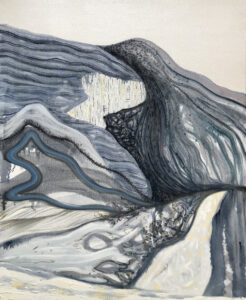 Teo Monsalve (Quito 1988, MFA Emily Carr University 2019), is a visual artist with a focus on painting, drawing, collage, printmaking, installation, and performance. By exploring themes related to the natural world of the Andes and the Amazon region of Ecuador, Monsalve is invested in developing and entangling a conversation with a variety of topics including history and landscape painting, the idea of the exotic as well as the sublime experience of nature. He has worked collaboratively with musicians as a way of expanding the rhythmic and vibrational elements of his aesthetic experiments. The predominant concerns in his practice are engaged with ideas of interculturality, interspecies relationships, geographical context and metamorphosis, both mythological and botanical. Weaving multiple narratives, drawn from his home country of Ecuador and his experience of living and studying in Canada Monsalve brings to his practice a range of influences reflecting a multicultural voice and his mestizo relationship with the Americas and the larger global sphere.
Teo Monsalve (Quito 1988, MFA Emily Carr University 2019), is a visual artist with a focus on painting, drawing, collage, printmaking, installation, and performance. By exploring themes related to the natural world of the Andes and the Amazon region of Ecuador, Monsalve is invested in developing and entangling a conversation with a variety of topics including history and landscape painting, the idea of the exotic as well as the sublime experience of nature. He has worked collaboratively with musicians as a way of expanding the rhythmic and vibrational elements of his aesthetic experiments. The predominant concerns in his practice are engaged with ideas of interculturality, interspecies relationships, geographical context and metamorphosis, both mythological and botanical. Weaving multiple narratives, drawn from his home country of Ecuador and his experience of living and studying in Canada Monsalve brings to his practice a range of influences reflecting a multicultural voice and his mestizo relationship with the Americas and the larger global sphere.
Where and what is Papallacta? How do you explore history and landscape painting? ‘Papallacta is a place in the Andes of Ecuador that connects the Amazon region of Ecuador with the high lands. Before the arrival of the Inca Empire it was known as the land of a wise Shaman, later became a Tambo, a resting place for Inca travelers when crossing the mountain range to arrive to Quito. For me it’s a portal by which you travel between dimensions. The trip of going from Quito to the jungle through this rode allows you to see different natural spaces and the flow of botanic life shifting from the high Andes to the jungle rivers. Papallacta is also well known because it has one of the most incredible hot springs right on the mountains. Is a place where you can bathe in volcanic water, this gesture of immersing your whole body in this water connects every single body cell to this landscape, you become one with the landscape.’
What does painting mean to you? How does painting help you analyze and question natural and human relationships? ‘History and landscape painting are entangled everywhere. In Ecuador as in Canada this tradition has a long colonial heritage. Ecuador´s national identity was built based on landscape painting. Our art history has been marked by different western travelers like Alexander Von Humboldt who inspired painters such as Frederic Edwin Church to come down to Ecuador and make some of the most incredible landscape paintings of western history (see ‘The Heart of the Andes’ for example, exhibited in the MET, NY). By studying painting in a contemporary art context these historical indicators are impossible to evade and has allowed me to analyze landscape painting with a critical perspective. As a consequence, I have engaged in exploring the landscape by phenomenological aspects that can connect my body to the territory by the use of metaphor, analogy and experience. Painting continues to be a way for me to explore this embodied knowledge, it allows me to see things that are invisible and also it establishes a dialogue that goes beyond rational thinking. I am inspired by the ideas explored in relational ontology, where the self is constituted in relation to the context. This relation goes beyond the human and it tries to establish dialogues with Earth Beings
the natural world. With our western minds is impossible to access these realms, that’s why I use painting, because it allows me to visualize the world beyond the constructed reality we experience. By doing so I also aim to decolonize painting, expand its discourse beyond formal dogmas established by modernism and introduce new voices from different latitudes in to the contemporary painting discourse, I see painting as a Pluriverse, a space for emergent voices in art to introduce their ways of knowing in to a visual tradition that is ever evolving.‘
Why is it important to live with art? ‘I think living with art is important because art is a material production that in some ways (maybe in the intention) escapes the self-destructive consumerism we are immersed in. Art, and specially paintings are objects made by one person, they are like magical objects that hold in them a record of energy applied through labour, and this energy could be understood as spirit. So in a way paintings are objects that signify through the image and also are energetic fields on their own. I think is important to have this objects that hold this power. They give a different flow of energy in a house. Anyone that lives with art would agree with me.’
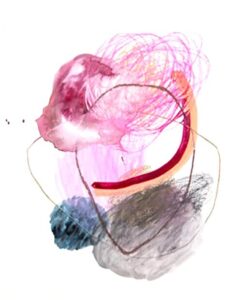 Katherine Duclos was born in Massachusetts in 1980 and received her MFA in Painting and Drawing from Pratt Institute in 2012. After 10 years in New York, she moved to Vancouver, BC in late 2017. She has exhibited her work in the US and in Canada. She has been a teaching artist for organizations such as Studio in a School and the Philadelphia Museum of Art. The following works by Katherine are presented by Monica Reyes Gallery.
Katherine Duclos was born in Massachusetts in 1980 and received her MFA in Painting and Drawing from Pratt Institute in 2012. After 10 years in New York, she moved to Vancouver, BC in late 2017. She has exhibited her work in the US and in Canada. She has been a teaching artist for organizations such as Studio in a School and the Philadelphia Museum of Art. The following works by Katherine are presented by Monica Reyes Gallery.
You often work in series. Can you tell us more about your Colour Stack and your Get Away series? ‘I like working in series because I can only do the same kind of work in variation for a short amount of time before I feel like I’m repeating myself and need a break. When I move on, it’s usually an evolution but it’s not always clear at first how the new work relates to previous work. I often have an orderly series and a disorderly series going at the same time. These two actually began in the exact same week in the fall of 2018, morphing from other previous series and I keep circling back to them.
‘Color Stacks is a slow and deliberate exploration of color and texture relationships, my own instincts, and what choices I make when I subvert those instincts. These pieces are about making choices from an infinite number of combinations and surprising myself. Get Away is more expressive, often tied to a sense of place or memory for me. There are subgroups within this series but they are all about embracing my instincts and being decisive. Both evolved from earlier series, both continue and will probably shift over time as well.’
In both of these series you seem to distill visual art and your subject into its elements and build from that. What is it about this separating and building process that is so seductive for you? ‘I think that’s a good way to describe this work. Repetition always plays a large role in my work. The marks and forms I create are part of a collection of elements, my visual lexicon, that I combine in different compositions for new results. There is always variation and deviation but I’m playing with the same processes in most of my work. At the same time as I was making these, I was also doing a lot of collage on panels using cut up paintings and scraps, so these are heavily informed by the collage process and approach to layering, texture, each step informed by the last.’
Why is it important to live with art? ‘A lot of my work deals with creating something that is evocative of the familiar, giving a viewer access, while also generating curiosity and wonder. Art can transport us, make us pause and think and remember;
having that in our home offers us a chance to momentarily be elsewhere or take a breath. I think many people don’t think it would make a difference, but it does. Our space makes us and others feel something and art can help define that feeling, shaping our experience.’
 Khan questions the seemingly ordinary moments of our day to day routines by observing the remarkable hidden within them.
Khan questions the seemingly ordinary moments of our day to day routines by observing the remarkable hidden within them.
Sara Khan was born in Birmingham, England in 1984 and raised in Lahore, Pakistan. She holds a BFA (with honours) from National College of Arts, Lahore (2008). She was selected for the Bag Art camp, an international art residency in Bergen, Norway (2012). She was also selected for the Vancouver Mural Festival (2018).
Her works have been featured in several national and international group exhibitions. In addition to her first solo show “Suraj Kinare” in Canada at the Surrey Art Gallery in 2019, recent group shows include “Terrestrial Beings”, Esplanade Arts and Heritage Centre, Medicine Hat, Canada in 2019, and “What is Seen and Not Seen, With or Without Seeing”, Gandhara Art Space, Karachi, Pakistan in 2017. Her work has also been featured in the book “A Big Important Artist: A Womanual” by Danielle Kryza.
Your work is charged with narratives, symbolism and imaginaries. Can you tell us how your cultural heritage and ancestors inform your work? ‘I believe my work is charged with narratives because my very first taste of art came from illustrations in children’s books, they made a relatively strong impact on my brain as a very young child.
‘The colours and patterns often found in my work are more reflective of my cultural heritage or at least the country I grew up in. Not only are you surrounded by heavily patterned clothes, even the trucks, rickshaws, mosques and shrines are quite colourful in Pakistan.’
How does watercolour help you express your ideas and memories? ‘I like to play with the fine line between what is real and what is imaginary. I find watercolour an incredibly versatile medium that allows me to sharpen the image if I like, and with the help of some extra water blur it to the extent I need.’
Why is it important to live with art? ‘Art is a universal language that has the ability to open us up to different perspectives. Its subtlety allows us to find new stories in it every time we observe it. Imagine how much you would continue to discover about yourself and the world if you have the privilege to live with it.’
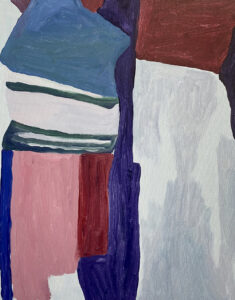 Alison Fast (b. 1992, Milwaukee, Wisconsin) is a visual artist who engages painting as a way of investigating the relationship between abstraction and representation. Through playful colouration, collage, digital processes, and casual gestures, Alison’s works hold movement, allowing entanglements of making and thinking to show themselves. Through her works, Alison pairs materiality and the liveliness of gesture. Through subtle figuration, play with colour, impulsive brushstrokes, and ambiguous compositions, Alison remains curious about possibilities beyond what she already knows with paint. From personal drawings, historical and contemporary painting, textile art and craft practices, her paintings act as autobiographical markers of time.
Alison Fast (b. 1992, Milwaukee, Wisconsin) is a visual artist who engages painting as a way of investigating the relationship between abstraction and representation. Through playful colouration, collage, digital processes, and casual gestures, Alison’s works hold movement, allowing entanglements of making and thinking to show themselves. Through her works, Alison pairs materiality and the liveliness of gesture. Through subtle figuration, play with colour, impulsive brushstrokes, and ambiguous compositions, Alison remains curious about possibilities beyond what she already knows with paint. From personal drawings, historical and contemporary painting, textile art and craft practices, her paintings act as autobiographical markers of time.
How do Amish quilts, children’s paintings and architectural elements meet in your work? ‘I’ve been looking at quilts recently, especially Amish quilts. I love that quilts capture a visceral quality of home. Quilting offers a way of merging ideas, colours, and patterns. Amish quilts have such surprising colour palettes. I like that feeling of being caught off guard. I learn so much from watching young children paint. Their freedom, confidence, casualness, and naivety is captivating. Architecture is a part of the work in the way that I am often taking pictures or making drawings from the places I am in. I hope for an element of what it feels like to be in a space to be in the paintings. In architecture, I’m often looking at how things are laid out, how they stack and hold each other up. There is balance and risk in architecture that I think about when planning paintings.’
How do time constraints play a part in your recent works and how does this help you employ an explorative approach to your painting? ‘Being a parent has changed how I think about time and making art. It is a fight to get time in the studio. This means that when I am making paintings there is urgency and a plan with an openness to derail the plan at any moment. bell hooks (1995) says it best when she says, “Women artists cannot wait for ideal circumstances to be in place before we find the time to do the work we are called to do; we have to create oppositionally, work against the grain” (p. 130). I work within my constraints and in doing so, I can see more of what is possible with them rather than what lacks.’
Why is it important to live with art? ‘Artworks reveal themselves slowly over time. An artwork continues living on in every encounter with it. By living with artworks, we can give them the committed attention they deserve. The willingness to be with an artwork is a willingness to be transformed and moved in however small or big a way. How incredible it is then to live with art that transforms.’
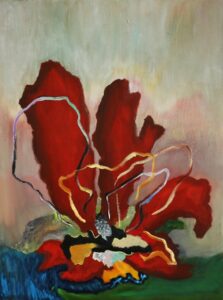 Tereza Tacic is a non-binary neurodivergent interdisciplinary artist based in the unceded homelands of the xwməθkwə yəm (Musqueam), sḵwx wú7mesh (Squamish) and səlilwətaɁɬ (Tsleil-waututh) Nations.
Tereza Tacic is a non-binary neurodivergent interdisciplinary artist based in the unceded homelands of the xwməθkwə yəm (Musqueam), sḵwx wú7mesh (Squamish) and səlilwətaɁɬ (Tsleil-waututh) Nations.
Tacic’s artistic practice aims to challenge the traditional concept that there is only one particular way doing, thinking or making something. Embracing their ADHD diagnosis, they allow themselves to process in- formation naturally with the goal of demonstrating to the viewer how neurodivergent brains navigate the world. Tacic’s process of making art is influenced by their consideration of the ways that creating art can help resolve internalized conflicts, being aware of their responsibility as an artist to represent their experience genuinely and openly. Thus, the pro- cess of how Tacic creates art is representative of how they aim to move earnestly and thoughtfully throughout their role of an artist in today’s society. The following works by Tereza are presented by TAS Vancouver.
How electric and volatile can thoughts and feelings be and how can they be translated into painting? ‘All thoughts, both good and bad, can be overwhelming. I’m trying to learn that the intensity which accompanies feelings doesn’t have to be feared. When we pause and acknowledge the feelings in their entirety, they’re able to move through us and out onto the canvas. It doesn’t always resolve the feelings, but it absolutely helps!’
How important is the process of making to your artistic process? ‘I would argue that it’s the most important part! Of course, it’s very satisfying having a completed work when all is said and done, but it’s the act of making which brings the fulfillment. By putting the process as a top priority, I’m able to access the flow state of art making that much more quickly. Being able to be actively present in the process is one of the greatest joys in my life.’
Why is it important to live with art? ‘For the same reasons it’s important to live with loved ones. Be it friends, family, plants, or pets, I believe art is very much so alive in its own way. The way you experience it changes daily depending on your mood, and that’s such a special treat you don’t understand until you share a home with art. It’s there with you experiencing life.’